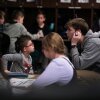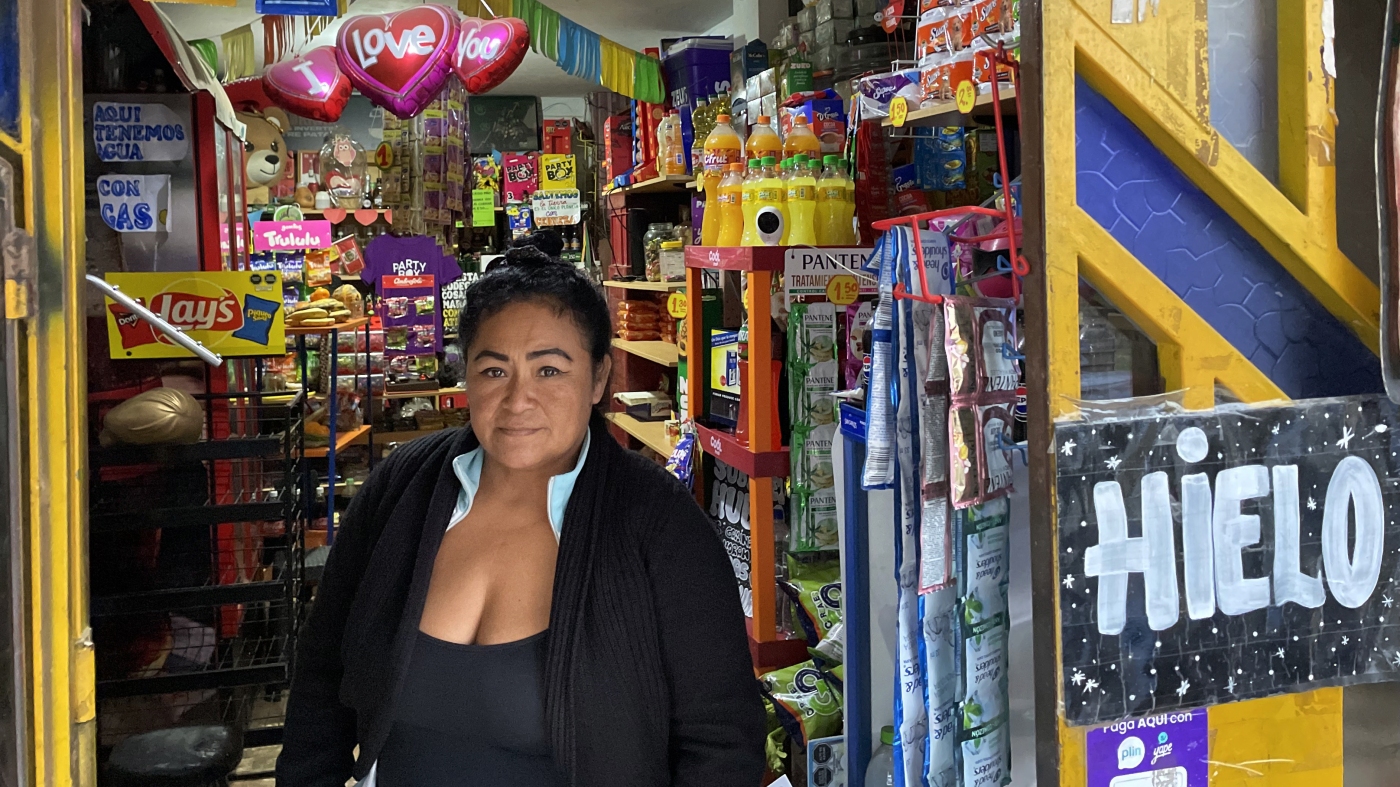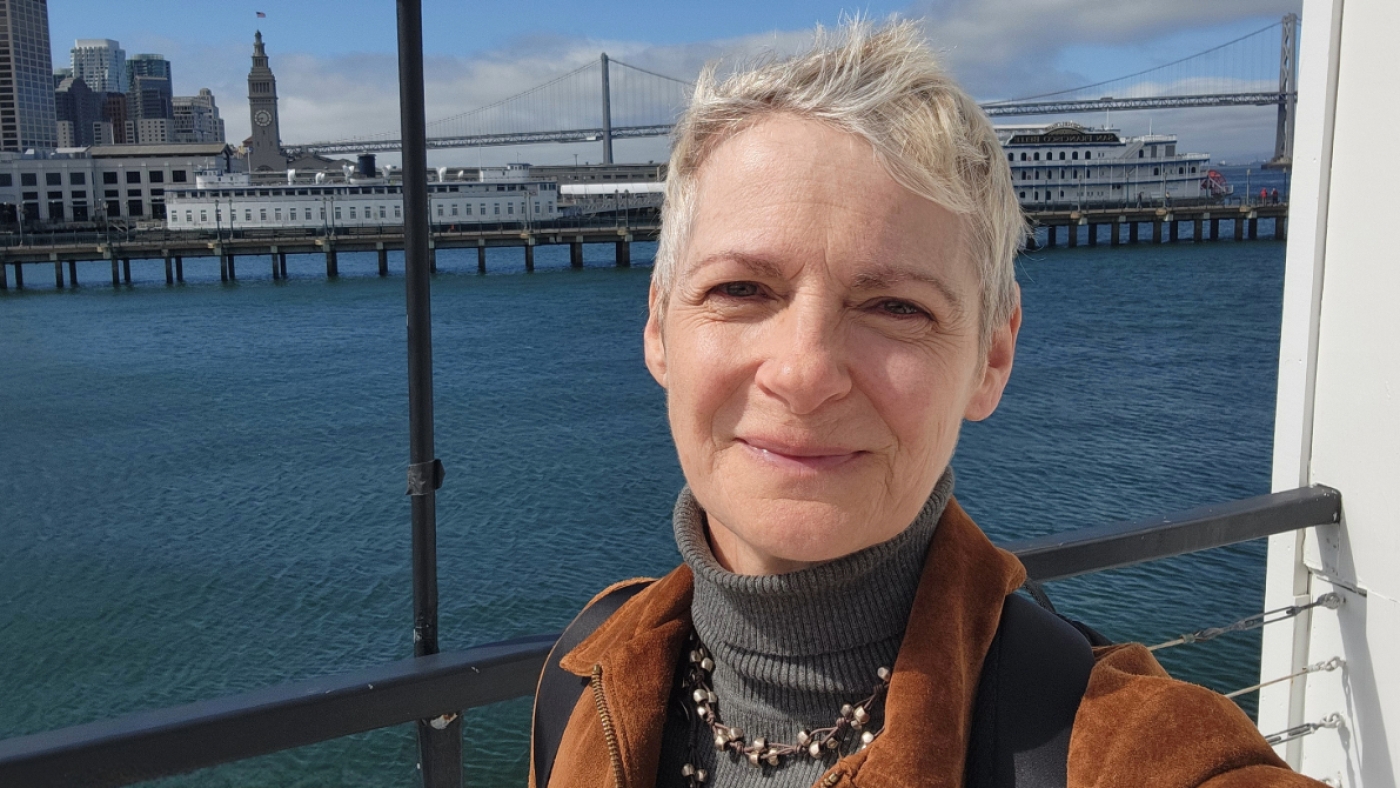
Kellen Hedler prepares to start his school day at Frontier Elementary School in Edmond, Okla. Katrina Ward for NPR hide caption
toggle caption
Katrina Ward for NPR
Kellen Hedler is actively engaged in his fourth-grade classroom: He raises his hand to correctly answer a math question, he reads prompts out loud for the class and he gathers with classmates to watch a science experiment during a lesson on erosion.
Kellen has Down syndrome, and he spends more than 80% of his school day with his non-disabled peers. That level of inclusion in a general education classroom involves a lot of thoughtful planning on the part of his teachers at Frontier Elementary School in Edmond, Okla.
Kellen's homeroom teacher, Adam Frederick, says that inclusion also came with a learning curve: Back in college, he studied to become a general education teacher, but he doesn't remember learning how to teach special education students like Kellen.
"They have you differentiate lessons for assignments," Frederick recalls of his college classes. "And then, when you're in it, you feel very underprepared. Because it's a real situation, you're dealing with real people. You don't want to mess it up."
Students with disabilities, like Kellen, are spending more time in general education classrooms. In 1989, less than a third of students with disabilities spent at least 80% of their day in general education, federal data shows. By 2022, that number had more than doubled.
That means general education teachers are more likely than ever to be working with students who have special needs. And yet, according to NPR reporting, the 10 largest universities in the country have a patchwork of special education requirements for future teachers.
When it comes to elementary teacher prep programs, which are designed to prepare students to earn state teaching certifications, six of those institutions require education students to take just one dedicated course in special education. The remaining four require more than one course.
But teacher prep degree paths are evolving. Some of the institutions that only require one course, including Texas A&M University and the University of Central Florida, told NPR they have bulked up the rest of their courses to infuse practices intended to reach every learner — not just typical ones.

Kellen's homeroom teacher, Adam Frederick, works with Kellen and other students on a math lesson. Katrina Ward for NPR hide caption
toggle caption
Katrina Ward for NPR
And a new kind of degree is also becoming more common: Dual-licensure or "unified" degree programs aim to prepare students to earn both general education and special education certification. These programs are sprouting up across the country, including at Texas A&M, Wichita State University, The Ohio State University and the University of Northern Iowa.
Lessons in special education don't only happen in special education classes
The University of Central Florida's teacher prep program has been under a gradual shift over the last seven years. Mary Little is a professor and program coordinator at UCF. She says the school has put a focus on learning from experience, and so its special education course is taught alongside a classroom internship.
"We're very [clearly] connecting theory and practice, collaboratively, within inclusive settings," Little says.
When teachers in training encounter questions in their internship classrooms, they can workshop them in real time with expert faculty. According to Little, challenges that come up include figuring out the appropriate learning accommodations for students with disabilities and working with Individualized Education Programs (IEPs), which are legal documents that outline the services and accommodations each student is entitled to.
Little says the school is also intentional about infusing inclusive practices throughout its teacher prep program. That includes emphasizing a teaching practice known as Universal Design for Learning, or UDL. It prioritizes flexible methods of instruction to meet the needs of students who may learn in a variety of ways.
For instance, in a first grade lesson on basic addition, a teacher could use pictures, tactile items and virtual tools to not only describe the math problem verbally, but also tangibly and visually.
"What might have, in the past, have been putting numbers up and having students look at those simple numbers, or giving students a worksheet and having them count off boxes or something has been expanded with UDL," says Andrea Borowczak, director of UCF's School of Teacher Education. "You're trying to be accessible for all students."
That also means not waiting for a child to be identified as having a disability before offering accommodations or specialized instruction.

Teacher Robyn Fox leads Kellen and his classmates in a lesson about the structure of the U.S. government. Katrina Ward for NPR hide caption
toggle caption
Katrina Ward for NPR
"It's really helping all of our [teacher prep] students to thoughtfully prepare lesson presentations and assessments, and ways to demonstrate learning over multiple pathways, so that more of the students can access, master and demonstrate curriculum and content knowledge," Little explains.
Little and Borowczak say their school is also working on a new dual licensure program in early childhood education and special education.
Currently, at least 4 of the 10 largest U.S. universities offer dual licensure or "unified" degree programs that prepare teachers to work in both general education and special education classrooms.
"All students are general education students"
Jennifer Kurth chairs the Department of Special Education at The University of Kansas, or KU, which recently debuted a unified degree geared toward future teachers who want to serve in either general or special education classrooms. It requires eight more special education courses than the school's traditional teaching degree.
There's just one catch: For students with disabilities to benefit from dual degree programs like this, people have to choose to enroll in them, over traditional education programs.
Kurth says it's going to require a paradigm shift to a philosophy that "all students are general education students."
"And if you leave a unified program knowing how to teach all students, you know how to individualize instruction; you know how to collaborate with people across disciplines; you know how to understand students, IEPs and understand the general education curriculum," Kurth says. "You're just going to be a more confident and more capable teacher."
Kurth says it's too early to say if the department would switch to a unified-only education program. But it's a possibility.
"I could honestly see a time in the near future where we do only have a unified program, because I think it has been really well-received," Kurth said. "We're maybe just a little cautious in trying to do too many big changes at once."
KU assistant professor Lisa Didion isn't shy about pitching the school's new unified degree program.
Last fall, during a special education course that's required for all KU education majors, she told her students that by joining the unified program, they would learn more strategies to reach all learners.
"And that's what's really going to make a difference, is that if we have general educators that are trained like special educators, then we are really going to start moving that [needle]," Didion said.
Benjamin Erickson, a junior majoring in elementary education, said he's considering switching to the unified program. He said as someone with disabilities, it's important to him to be part of a "better system."
"Knowing that about kids who are coming into my classroom and learning how to support them is really important," Erickson said. "But also, when you have an inclusive classroom and you make sure that everybody feels supported and everybody has what they need, everybody is able to succeed."

 2 months ago
44
2 months ago
44



















































